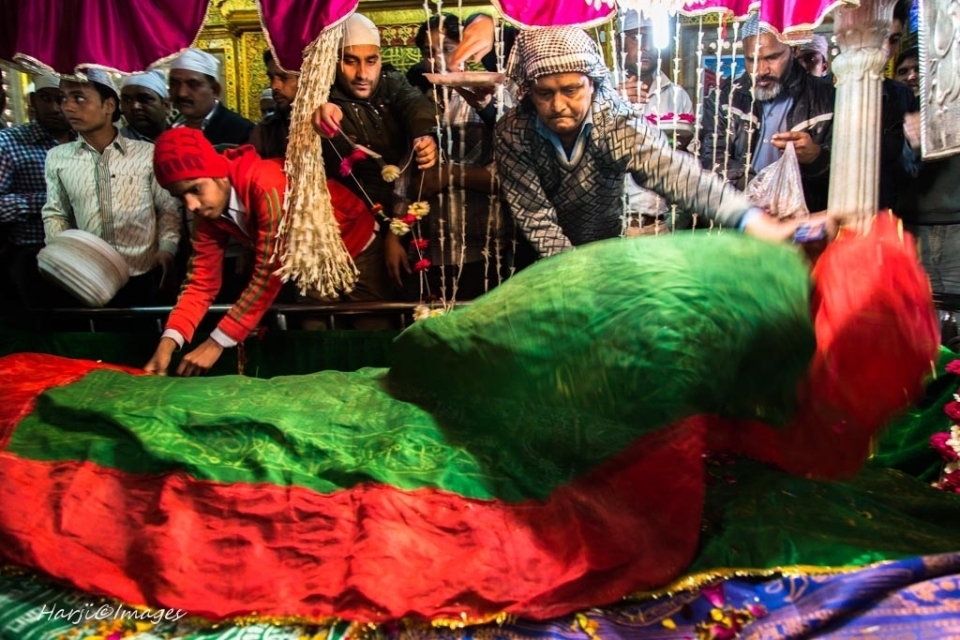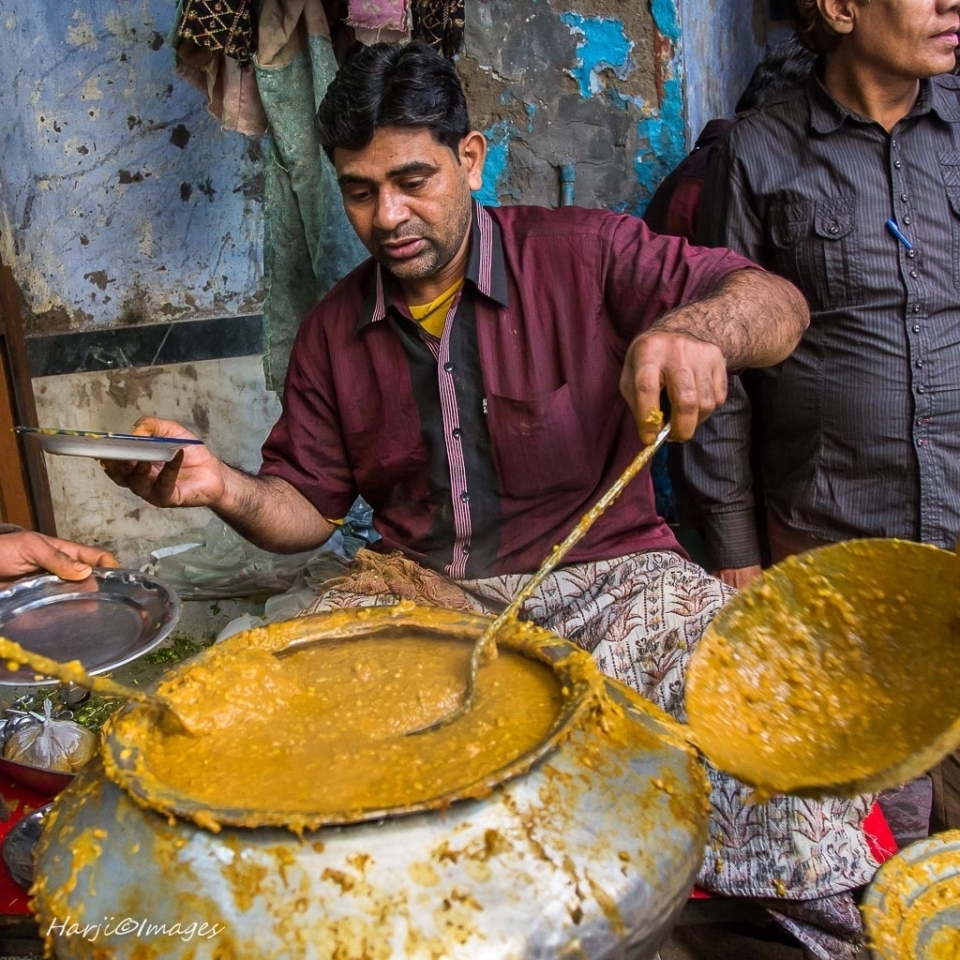Photo Essay: The Dargah of Hazrat Nizamuddin Auliya and its Surrounding Neighbourhood Through the Lens of Muslim Harji
BY MUSLIM HARJI

This is the dargah of one of the most famous Sufi saints, Nizamuddin Auliya. Situated in Nizamuddin West, it also houses the tomb of poet Amir Khusro and Mughal princess Jahanara lying adjacent to the complex. Thousands of Muslims, Hindus and those of other faiths and religions visit it every week, especially on Thursdays to witness the beautifully lit up dargah after sunset accompanied by soulful Sufi music. Photo: Muslim Harji. Copyright.
Editor’s note: “How does a place like the [Nizamuddin] basti survive in the heart of modern Delhi? What has produced it? What holds it together?” In seeking to answer these questions, Michael Thomas Snyder in a comprehensive study on the subject published in the Columbia Undergraduate Journal of South Asian Studies states at the very beginning of his illuminating piece that “every question about the basti leads eventually to the dargah that sits at its centre and the life of the Saint buried therein. The dargah of Hazrat Nizamuddin Aulia is the unquestionable historic, religious, and geographic origin of the neighborhood, the reason it came into existence, and the reason it continues to draw visitors from the world over.” [1]
Muslim Harji, contributor of several fascinating photo essays for this website, captures the spirit of dargah (Muslim tomb or shrine) and the Nizamuddin basti (neighbourhood) with a series of remarkable photos that he took during his trip to New Delhi. Harji notes that his trip to the Indian capital would have remained incomplete without visiting the Nizamuddin basti, which is the the heart and soul of New Delhi. It is in the basti that one feels the soothing presence of both Hazrat Nizamuddin Auliya and his famous Sufi disciple, Hazrat Ameer Khusro.
HAZRAT NIZAMUDDIN AULIYA AND THE BASTI
Hazrat Nizamuddin Auliya was born in Badayun, Uttar Pradesh to parents that had migrated from Bokhara in Central Asia. Among the first important Sufi Saints born on the subcontinent, Nizamuddin Auliya encouraged the development and spread of medieval Sufi practices amongst Hindus of North India through his emphasis on equality, charity, and religious syncretism. By incorporating traditional ritual practices of the subcontinent—most famously the use of music in worship—Nizamuddin and other great Saints of the Chishti order indigenized Islam on the subcontinent, so much so that scholars and religious figures, both those sympathetic to and those opposed to Sufi practices, have attempted to trace its origins to India. His success amongst all populations and his openness to followers of all religious backgrounds has lent to his reputation as a great missionary in the name of Islam. [1]
The neighbourhood has one of the highest densities of medieval Islamic buildings anywhere in the world with over 100 monuments. “With over 700 years of living culture—it’s not only bricks and mortar, it’s Amir Khusro and Ghalib and qawwali,” said Ratish Nanda of the Aga Khan Trust for Culture in India which has carried out restoration works on the gardens of Humayun’s tomb. [2]
_________________
AT THE ENTRANCE AND INSIDE THE BASTI

As you enter the complex, you comes across various phoolwala (florist) stalls, chadar (thick garment sheet) vendors, Urdu book depots and famous food shops that take you to a bygone era. A unique and mystic character surrounds the complex, which separates it vastly from the fast moving pace of New Delhi. Photo: Muslim Harji. Copyright.

Phoolwalla. Photo: Muslim Harji. Copyright.

Chadarwallah. Photo: Muslim Harji. Copyright.

Many Delhi residents are unaware of the richness hidden in the gallis (alleys) of Nizamuddin basti such as dargahs, tombstones, mosques, culinary delights, and qawalli recitations. Photo: Muslim Harji. Copyright.

The dargah of Hazrat Ameer Khusro – A Sufi mystic and a spiritual disciple of Nizamuddin Auliya of Delhi, Ameer Khusro was not only a notable poet but also a prolific and seminal musician. He is regarded as the “father of qawwali” (the devotional music of the Indian Sufis). He is also credited with enriching Hindustani classical music by introducing Persian and Arabic elements in it, and was the originator of the khayal and tarana styles of music. The invention of the tabla is also traditionally attributed to Amir Khusro. Above all, he was a most dutiful and devoted mureed of Hazrat Nizamuddin Auliya, the spiritual monarch of his day in the subcontinent. Photo: Muslim Harji. Copyright.

Agarbatti Wallah (one who sells incense) – While walking deeper inside the basti, the bursting aroma of sandalwood agarbattis mingle with the smell of the city and the open courtyard of the dargah is gradually filled with men and women. The agarbattis and diyas brightens up the dark closure, with each person lighting up to 20 agarbattis at a particular time in order to get purified of the evil and to clean the air of the surrounding negativity. It is said that the saint’s powers can cure people from all the djinns and negativity surrounding their bodies and hence leave them purified. Photo: Muslim Harji. Copyright.

Jaalis (Trellise) – Believers also tie thread in the form of wishes (mannats) on the jharokhas of the dargah in the strong belief that the saint will grant all their desires. It is believed that purity of thought and heart is essential for any mannat to get fulfilled. Photo: Muslim Harji. Copyright.

The dargah receives an average of 50,000 visitors a day, with the number rising to double that on Thursdays. Photo: Muslim Harji. Copyright.

Photo: Muslim Harji. Copyright.

Photo: Muslim Harji. Copyright.
_________________
THE SANCTUM

Inside the sanctum, a layer of rose petals and chaddars many inches thick, the grave surrounded by a circumambulating line of men praying for the deceased, or seeking his intercession in the redressing of their pleas. Photo: Muslim Harji. Copyright.

The Chaddar (Paying Homage) ritual. Photo: Muslim Harji. Copyright.

Photo: Muslim Harji. Copyright.

The young and the old come together to offer their prayers and perhaps experience higher levels of consciousness. Photo: Muslim Harji. Copyright.

Photo: Muslim Harji. Copyright.
_________________
QAWWALI

The qawwali is held in front of the main entrance of the dargah of the Nizamuddin. The young and the old come together to offer their prayers and perhaps witness higher levels of consciousness, which resonates during the qawwali performances. Photo: Muslim Harji. Copyright.
_________________
THE JAMAAT KHAANA MOSQUE

Photo: Muslim Harji. Copyright.

Inside the Jamatkhana mosque at the dargah. An unusual mosque, in that it’s octagonal rather than the more conventional four-sided building. Photo: Muslim Harji. Copyright.
_________________
THE CULINARY DELIGHTS OF THE BASTI
In and around the Basti, you will find the finest Mughali cuisine, not to mention Boti Kabab, Tikka, Seekh kababs, Muglahi Biryani and the best Haleem in Delhi.

Chicken Tikka. Photo: Muslim Harji. Copyright.

Mughlai Mutton Biryani. Photo: Muslim Harji. Copyright.

Seekh Kabab at Karims. Photo: Muslim Harji. Copyright.

The best Haleem in Delhi. Photo: Muslim Harji. Copyright.
_____________________
A SYNOPSIS OF THE WORK OF THE AGA KHAN TRUST FOR CULTURE IN NEW DELHI
In 1997, the Aga Khan Trust for Culture (AKTC) stepped into a part of Delhi that was sandwiched between a busy railway station and a large urban slum, Nizamuddin. As a microcosm of the city, the area presented a slew of challenges. Seven hundred years of continuous habitation had by now included a Muslim ghetto with no sanitation or water, a ghetto that spilled over into the most visited pilgrim site in the city — the dargah of the 14th century Sufi saint Nizamuddin Auliya. It’s also the place where qawwali was invented and where its creator, poet-philosopher Amir Khusrau lived and died. Very close to the dargah was the tomb of the second Mughal emperor Humayun. Parts of its fine red sandstone were chipping and even with a lofty status of the World Heritage Site, the tomb looked like a bedecked bride jilted by time. The Aga Khan Trust decided that if this part of Delhi’s heritage was to be brought back to life, it could not be piecemeal. It had to be all or nothing. In case of the former, the area to be restored would include Humayun’s Tomb, Nizamuddin Dargah, the old botanical gardens, 50 other monuments and, most of all, the culture of the people of Nizamuddin. [2]
Date posted: October 13, 2016.
________________
[1]. “Where Delhi is Still Quite Far: Hazrat Nizamuddin Auliya and the Making of the Nizamuddin Basti,” by Michael Thomas Snyder, Columbia Undergraduate Journal of South Asian Studies (Please read complete article at http://www.columbia.edu/cu/cujsas/Volume%20I/Issue%20II/Michael%20Snyder%20-%20Where%20Delhi.pdf).
[2]. Compiled from “Nizamuddin Basti Puts Out Welcome Mat” by Tripti Lahiri.
For Muslim Harji’s profile and links to his other photo essays on this blog, please click Contributors.
We welcome your feedback on this post. Please post your comments below.
Your blog is a complete virtual journey into the world of Sufis. You have covered every corner inside and outside and that’s wonderful.
It is one of the best narratives with “breath taking beautiful ” and exquisite photographs. I was there in 1998 – the place still haunts me. This post enlivened memories and highlighted a great loss of “Tolerant Indian Islam”. Bless you
Very well narrated, Muslim. And of course, beautiful photos as always !!
A beautiful famous site. We were there last year and these photographs have captured the true essence of this historic site.
Excellent photos of the dargah and basti of this Sufi saint.
You never cease to amaze. We love your honest, creative talent to capture such beautiful pictures and share them with even more meaningful synopsis. It always takes us to all these wonderful places. Thank you and take care.
Nazim and Shenaz Ladhani,
Charleston,
South Carolina.
Pingback: Photo Essay: The Dargah of Hazrat Nizamuddin Auliya and its Surrounding Neighbourhood Through the Lens of Muslim Harji | gulzara
These pictures open windows onto shapes, colors and beauties of less-known corners of the world.
Always creative and wonderful photos..thanks dear Muslim and Nevin.
Muslim well done and keep it up.
Excellent depiction and capture of a famous site. The photos are magnificent and the essay provides an educational lesson. Thank you.
Brilliantly done Muslim. Improved my general knowledge. Thank you and best wishes.
Excellent shooting, Sir! Stay well and regards to the beautiful Mrs Nevin.
Excellent shooting, Sir! Stay well and regards to the beautiful Mrs. Nevin.